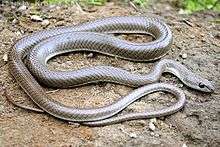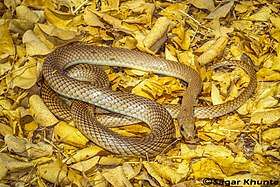Psammophis longifrons
Psammophis longifrons, the stout sand snake or long sand racer, is a species of snake found in India (Maharashtra).[1][2] It can grow to a maximum length of 57 inches (145 centimetres).[3]
| Long sand racer | |
|---|---|
 | |
| Subadult Psammophis longifrons | |
| Scientific classification | |
| Kingdom: | Animalia |
| Phylum: | Chordata |
| Class: | Reptilia |
| Order: | Squamata |
| Suborder: | Serpentes |
| Family: | Lamprophiidae |
| Genus: | Psammophis |
| Species: | P. longifrons |
| Binomial name | |
| Psammophis longifrons Boulenger, 1896 | |
Description
Greyish above in front, browner behind, the scales edged with black, particularly those of vertebral region. The top of the head is uniform greyish brown, or the scales are edged with black. Greyish or yellowish below. Total length 1230 mm, tail 375 mm. Of considerably stouter build than the other Indian member of this genus.

Morphometrics
Maxillary teeth 12 or 13, 2 in the middle very strongly enlarged, and preceded and followed by a distinct interval; internasal small, 1/2 or less than 1/2 the length of prefrontals; frontal long and narrow, not longer than its distance from end of snout, the anterior end suddenly not enlarged, not greatly broader there than in the middle, not in contact with the preocular; temporals 2+2, 8 Supralabials 4th and 5th touching eye. V.166-175; C.79-93; A.2
Distribution
In Maharashtra it is reported from Bombay presidency north of 19 degree (Thana and Damanganga districts, Bulsar, Panch Mahal), C.P(Nagpur) and Amravati. In Gujarat; Surat, Valsad, Navsari. In Madhya Pradesh it is recorded from Ujjain and Hoshangabad. These records show that this species is distributed in a very narrow range, including three western Indian states, namely Gujarat (central and south), Maharashtra (northern) and Madhya Pradesh (mainly southern west).
Food and behaviour
Its habits are both terrestrial and arboreal.
In captivity (for a short period), it was observed that the snakes were timid and well set without any aggression. Five types of lizards (Hemidactylus flaviviridis, H. triedrus, Calotes versicolor, and Eutropis carinata and four types of frogs (Duttaphrynus melanostictus, Euphlyctis cyanophlyctis, Sphaerotheca breviceps, and Polypedates maculatus were provided and accepted as food.
Reproduction
A female collected in Gujarat laid eight capsule shaped eggs.
References
- Boulenger, G. A. (1896). Catalogue of the snakes in the British Museum. London: Taylor & Francis. pp. xiv, 727.
- Vyas, Raju (1897). "Collection of a stout sand snake". 12 (2): 7–8. Cite journal requires
|journal=(help) - Nande, Raghavendra; Deshmukh, Sawan (December 2007). "Snakes of Amravati District including Melghat, Maharashtra, with important records of the Indian Egg-Eater, Mountain Trinket Snake and Indian Smooth Snake" (PDF). Zoos' Print Journal. 22 (12): 2920–2924. doi:10.11609/jott.zpj.1653.2920-4.
- Smith M. A. (1943), The Fauna of British India, Ceylon and Burma, Including the Whole of the Indochinese Subregion. Vol. III. Serpentes, Taylor and Francis, London.
- Vyas and Patel (2013), NOTES ON DISTRIBUTION AND NATURAL HISTORY OF Psammophis longifrons BOULENGER 1896 (SERPENTES: PSAMMOPHIIDAE: PSAMMOPHIINAE) IN GUJARAT, INDIA. Russian Journal of Herpetology. Vol. 20, No. 3, 2013, pp. 217 – 222